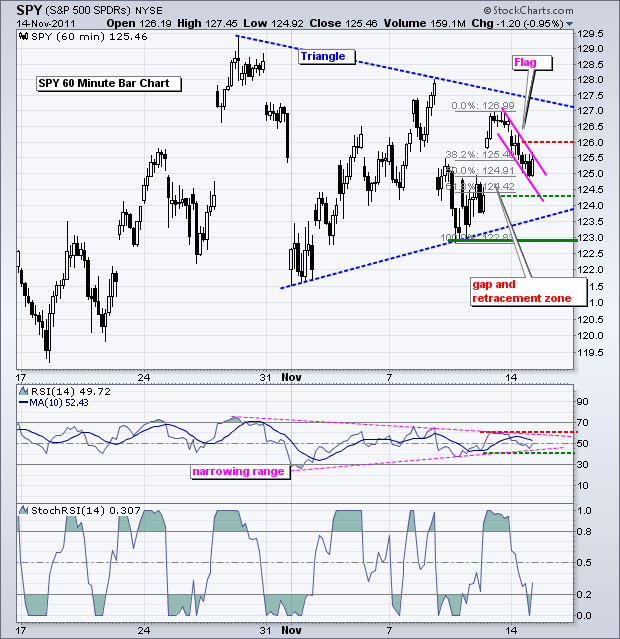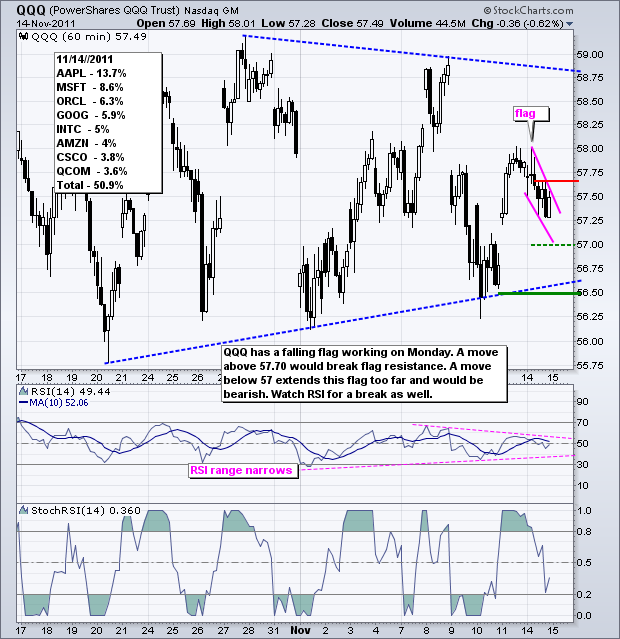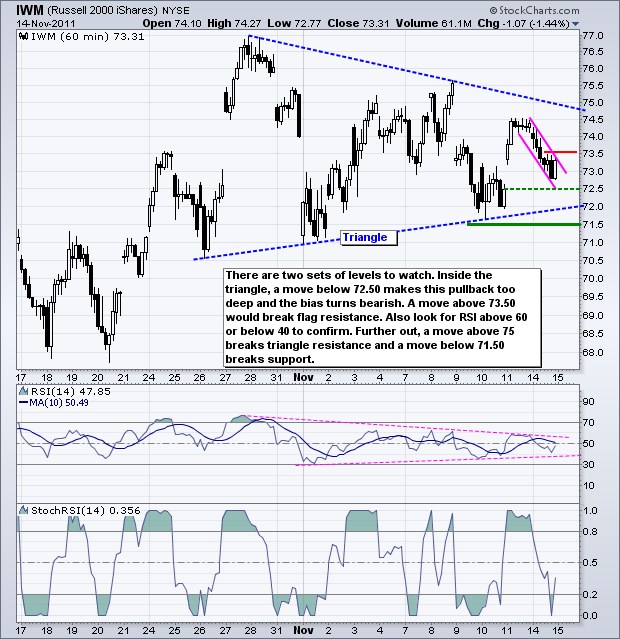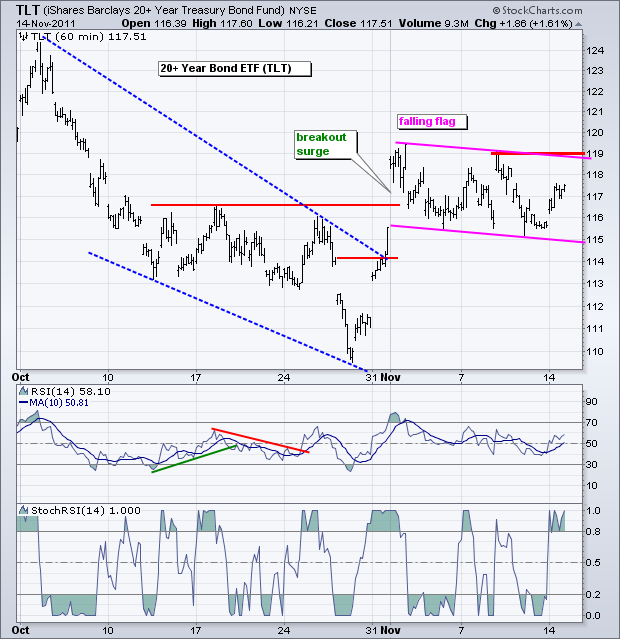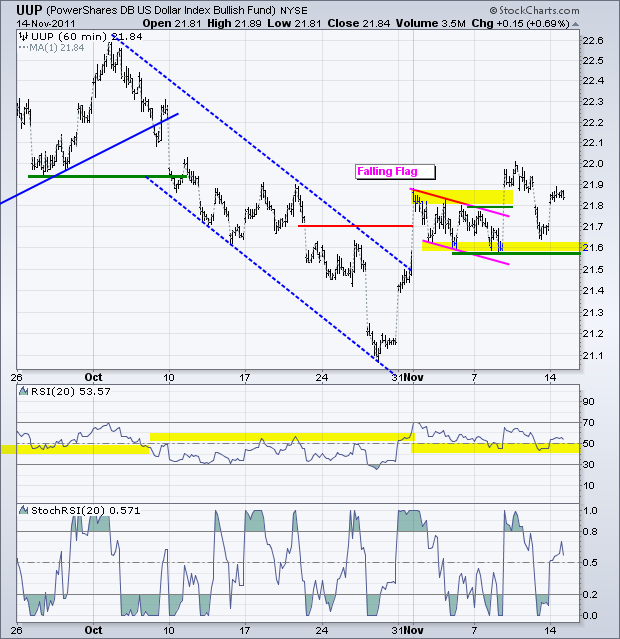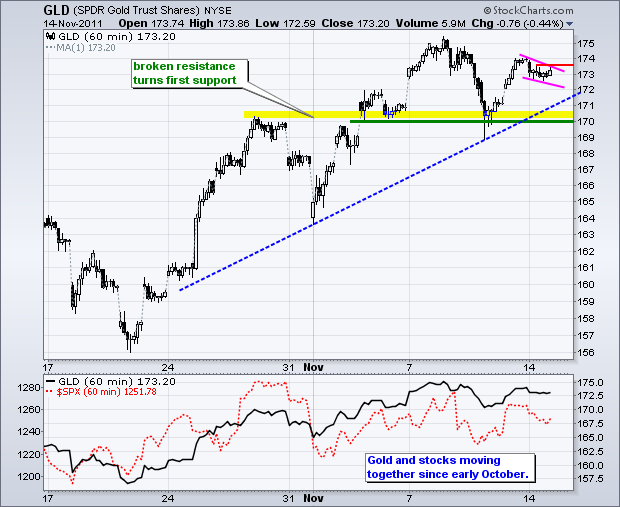The price swings are getting shorter as the triangle tightens in the S&P 500 ETF (SPY). While it is hard to act on every swing within the triangle, this is the only way to anticipate the triangle breakout. Those not acting on the internal swings, would simply wait for a move above triangle resistance (127.5) or below triangle support (123). After gapping up on Friday, SPY hit resistance at 127, which is below the prior high at 128. A lower high shows no follow through and questions bullish resolve. With Monday's move lower, the ETF has retraced around 50% of last week's bounce (123 to 127). The 50-61.80% retracement zone and gap mark the make-or-break zone. A successful pullback should stop and reverse in this area. A move below 124.30 would exceed this zone and totally fill Friday's gap. This would be the first sign of a potential triangle support break further down. For the falling flag, I would mark resistance at 126. A move above this level would provide the first hint that an upside breakout is in the making. The range in RSI also narrowed over the last few weeks. After exceeding 70 in late October and 30 in early November, RSI failed to exceed these levels last week. The range narrowed further the last few days. Watch 60 for an upside breakout and 40 for a downside break.
**************************************************************************
The 20+ year Bond ETF (TLT) perked up on Monday as stocks and the Euro moved lower. Even though the world is in a massive de-leveraging, US and German Treasuries still attract money as relative safe-havens. "Relative" is, of course, the key word here. TLT reversed the downtrend with a surge above 117 on November 1st. The ETF has since been in corrective mode with a falling flag. Monday's bounce off support is the first positive sign. A breakout at 119 would signal a continuation higher. This would be negative for stocks and the Euro.
**************************************************************************
The US Dollar Fund (UUP) fell back below the flag breakout on Friday, but bounced off support on Monday to keep the bigger uptrend alive. UUP reversed its downtrend with the surge/breakout on November 1st. This is also when TLT reversed its downtrend. The falling flag was a bullish continuation pattern and it looks like the uptrend is set to continue, which could be negative for stocks. The November lows mark key support.
**************************************************************************
The US Oil Fund (USO) followed stocks lower with a decline on Monday. The ETF moved below 38 and then consolidated. A short-term support level is set at 37.50 and a break below this level would argue for a deeper pullback. Key support remains in the 36-36.50 area. This zone is confirmed by a 50-61.80% retracement of the November advance.
**************************************************************************
The Gold SPDR (GLD) affirmed short-term support in the 170 area with a bounce last week. The ETF consolidated its gains with a falling flag/wedge on Monday. A move above 173.50 would break flag/wedge resistance and signal a continuation higher. Gold has been positively correlated with the stock market since early October as both moved higher the last 6-7 weeks. Gold seems to favor a risk-on environment, which means a return to the risk-off environment could be bearish for bullion.
**************************************************************************
Key Economic Reports:
Tue - Nov 15 - 08:30 - Producer Price Index (PPI)
Tue - Nov 15 - 08:30 - Retail Sales
Tue - Nov 15 - 08:30 - Empire Manufacturing
Wed - Nov 16 - 07:00 - MBA Mortgage Index
Wed - Nov 16 - 08:30 - Consumer Price Index (CPI)
Wed - Nov 16 - 09:15 - Industrial Production
Wed - Nov 16 - 10:00 - NAHB Housing Market
Wed - Nov 16 - 10:30 - Oil Inventories
Thu - Nov 17 - 08:30 - Jobless Claims
Thu - Nov 17 - 08:30 - Housing Starts/Building Permits
Thu - Nov 17 - 10:00 - Philadelphia Fed
Fri - Nov 18 - 10:00 - Leading Indicators
Charts of Interest: Tuesday and Thursday in separate post.
This commentary and charts-of-interest are designed to stimulate thinking. This analysis is not a recommendation to buy, sell, hold or sell short any security (stock ETF or otherwise). We all need to think for ourselves when it comes to trading our own accounts. First, it is the only way to really learn. Second, we are the only ones responsible for our decisions. Think of these charts as food for further analysis. Before making a trade, it is important to have a plan. Plan the trade and trade the plan. Among other things, this includes setting a trigger level, a target area and a stop-loss level. It is also important to plan for three possible price movements: advance, decline or sideways. Have a plan for all three scenarios BEFORE making the trade. Consider possible holding times. And finally, look at overall market conditions and sector/industry performance.

